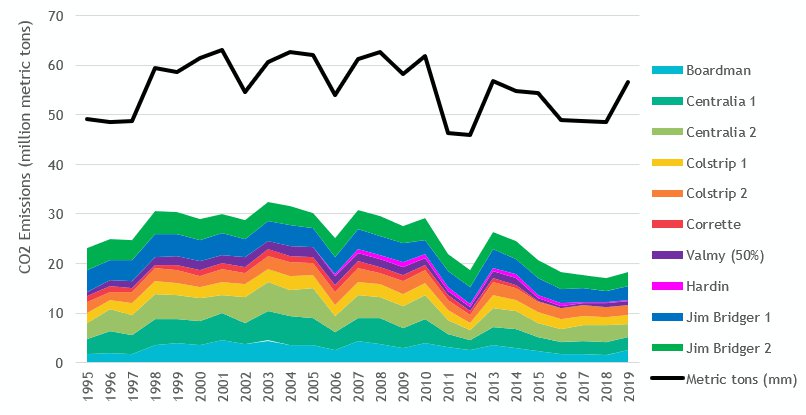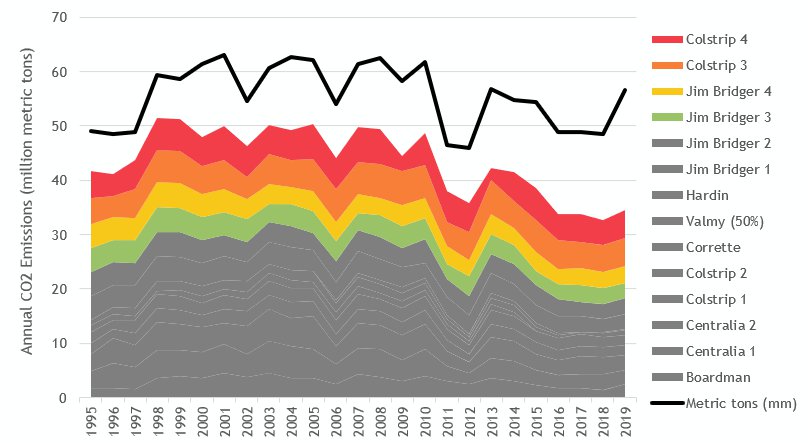Coal
Following the development of the Columbia River hydropower system, coal and nuclear power were viewed as the most economical new sources of electricity. Between 1968 and 1986, 14 coal-fired units at six sites were brought into service by Northwest utilities – Boardman (Oregon), Centralia (Washington), Colstrip (Montana), J.E. Corette (Montana), Jim Bridger (Wyoming), and North Valmy (Nevada). At its height, the region’s coal capacity (including several smaller coal units) totaled around 7,300 megawatts and coal was a significant contributor to reliable and relatively cheap regional energy.
As the policy landscape shifts to an emphasis on decarbonization, the coal industry has been grappling with what the future holds for the carbon-emitting resource. The economics that previously swung in favor of cheap coal generation have dramatically altered with consistently low natural gas prices and low-cost renewable resources with low or no variable operating costs. For coal plants that opt to continue operations, additional capital investment is often required in order to comply with various federal environmental regulations. In addition to clean and renewable policies at the state, city, and utility levels, policies that prohibit the generation of coal-fired power have been enacted in several western-interconnect states – including Oregon and Washington – forcing the early closure of coal units, expediting the conversion to natural gas, or looking to alternative technologies such as carbon capture and sequestration.
Pacific Northwest: Coal Units
| Coal Unit | In-Service Year | Nameplate Capacity (MW) | Planned Retirement |
| North Valmy 1 | 1981 | 277 | 2019*/2021 |
| Colstrip 1 | 1975 | 358 | Jan 2020 |
| Colstrip 2 | 1976 | 358 | Jan 2020 |
| Boardman | 1980 | 601 | Oct 2020 |
| Centralia 1 | 1972 | 730 | Dec 2020 |
| Jim Bridger 1 | 1974 | 608 | 2023 |
| Centralia 2 | 1973 | 730 | 2025 |
| North Valmy 2 | 1985 | 289 | 2025* |
| Jim Bridger 2 | 1975 | 617 | 2028** |
| Colstrip 3 | 1984 | 778 | – |
| Colstrip 4 | 1986 | 778 | – |
| Jim Bridger 3 | 1976 | 608 | – |
| Jim Bridger 4 | 1979 | 608 | – |
* Idaho Power ceased its participation and divested its 50% ownership in North Valmy unit 1 in 2019, however the unit is planned to retire at the end of 2021. Idaho Power is also considering a similar early exit from North Valmy unit 2 in 2022, although this has yet to be confirmed.
** PacifiCorp and Idaho Power are still working out details on the retirement of Jim Bridger 2; this date could be accelerated further.
Over the next decade, the region is set to lose about 4,400 megawatts of its coal capacity through planned coal unit retirements. The remaining 2,500 megawatts coal capacity in the region post-2028 will be largely from Colstrip 3 and 4 and Jim Bridger 3 and 4. The future of these units, however, remains uncertain.
Pacific Northwest: Planned Coal Unit Retirements

With the development of natural gas projects in the region and the low price of natural gas fuel, coal’s edge in the region’s order of dispatch has been gradually slipping. Further, as coal units are closing or facing uncertain futures and/or capital investments, coal generation has been declining and will continue to do so.
Fossil Fuel Generation in the Pacific Northwest

In terms of regional carbon emissions, even with an increasing amount of overall fossil fuel generation (coal + natural gas) throughout the years, because less coal is generated in favor of cheaper natural gas, emissions have been declining. The amount of overall fossil fuel generation (and subsequent emission), however, depends heavily on the year’s hydropower production. In good hydro years, less fossil fuel generation is needed, while in poor hydro years, more fossil fuel generation is produced to help supplement the hydropower system. The year 2019 was a very poor hydro year, and thus the region’s coal and natural gas units generated more and emissions were higher.
Since 1995, all coal power production has accounted for about 80% of the region’s overall power plant carbon emissions, although that varies annually and has been declining overall with greater reliance on natural gas. In 2019, coal accounted for about 60% of the region’s power plant emissions. As coal units begin to retire, regional emissions will decline significantly, although the exact amount depends on the replacement resources. Of the units already retired or planned to retire through 2028, on average they have contributed 46% of the region’s annual emissions since 1995. This has declined over time, and in 2019, even though it was a poor hydro year, these units only contributed 32% to the overall carbon emissions. Four of the largest coal units in the region – Colstrip 3 and 4 and Jim Bridger 3 and 4 –have yet to announce any formal plans for retirement. Together, these four units have accounted for on average 32% of historical power plant emissions since 1995. The year 2020 was the first significant year of regional coal retirements, however the final generation and emission data is not yet available.
PNW CO2 Emissions: Share of Emissions from Planned Coal Unit Retirements

PNW CO2 Emissions: Share of Emissions from All Coal Units

Uncertain Futures
While there have been significant coal unit retirements announced and already completed in the Pacific Northwest, there are four major coal units whose futures remain uncertain – Jim Bridger 3 and 4, and Colstrip 3 and 4. The owners of Jim Bridger 3 and 4 (PacifiCorp and Idaho Power) have expressed in their respective integrated resource plans that it is economical for them to pursue an early exit from both units, however a final agreement with official closure dates has yet to be announced. The uncertainty surrounding Colstrip 3 and 4 is even greater. With six owners across the two units, each owner has its own vision of what the future of these units looks like. Some owners seek an early exit for economic and/or environmental reasons, while others see the units as a key resource in their long-term strategies. In addition, there are coal generation prohibitions in Washington and Oregon approaching in 2025 and 2030, respectively, that will force decisions to be made about the future operations of these units.
The 2021 Power Plan explores retiring all coal units in the region (by 2027) and WECC-wide (by 2030) in its Early Coal Retirement scenario. The plan also explores a sensitivity analysis to test the reliability and adequacy of the power system when Colstrip 4 operates until 2042.



